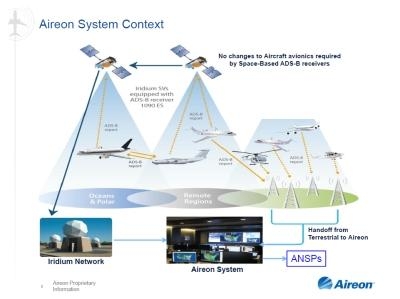Single Aireon Payload Received 6,935 ADS-B Messages From The NAV CANADA Test Aircraft Flying In The Montreal, Winnipeg And Edmonton Airspace
NAV CANADA has completed a successful flight test of space-based ADS-B technology. The test was conducted to collect ADS-B data used for validating Aireon's satellite aircraft surveillance and tracking service. The NAV CANADA flight occurred on March 7, 2017 and utilized a specially equipped Bombardier aircraft with both top and bottom mounted 125 watt ADS-B antennas. It was the first of two scheduled flight tests by the Canadian Air Navigation Service Provider (ANSP). Additional flight tests were done by the FAA and Polaris Flight Systems.

During the flight test, 6,935 ADS-B messages were received and decoded by a single Aireon payload, and after rigorous analysis, were found to exhibit comparable results to that of terrestrial ADS-B stations. Traveling through the Montreal, Winnipeg and Edmonton Flight Information Regions (FIRs), the flight test was a highly choreographed exercise requiring the aircraft to position itself in the correct airspace while the appropriate Iridium NEXT satellite carrying the Aireon ADS-B receiver was overhead.
An additional flight test with the FAA took place on Thursday, March 30, 2017, utilizing the FAA's specially equipped "flying laboratory" Bombardier jet with three Aireon payloads available to receive data. A total of 2,462 ADS-B messages were received and decoded while also exhibiting comparable results to that of terrestrial ADS-B stations. The FAA flight test took place in the Washington and New York FIRs.
Aireon also conducted a flight test with Polaris Flight Systems, a private vendor, on March 20, 2017. The aircraft, a Beechcraft Bonanza, was outfitted with a top and bottom mounted 200 watt ADS-B antenna and flew solely through the Albuquerque FIR, where more than 1,050 ADS-B messages were received from two Aireon payloads during the flight.

"The flight tests coordinated with NAV CANADA, the FAA, and Polaris Flight Systems have been remarkable successes and further enable our team to thoroughly validate the capabilities of our system," said Vinny Capezzuto, chief technology officer and vice president, engineering at Aireon. "Through multiple flight information regions, with various levels of aircraft traffic, these tests were able to put our system through some challenging environments, and the data we've received is incredibly strong."
"NAV CANADA is excited to play such an important role in helping to bring the next-generation of air traffic surveillance and aircraft tracking to the world," said Rudy Kellar, executive vice president, service delivery at NAV CANADA. "Aireon will fundamentally change the way the world flies, increasing safety, efficiency and reducing greenhouse gas emissions. The benefits will find their way right down to the individual traveler who will benefit from more predictable flight times and more efficient airport ground operations."
Aireon's space-based ADS-B system will be operational in 2018, providing ANSPs with global air traffic surveillance and airlines with real-time flight tracking. The first ten Iridium NEXT satellites carrying the Aireon hosted-payloads were launched into low-Earth-orbit from Vandenberg Air Force Base on a SpaceX Falcon 9 rocket on January 14, 2017. Seven additional SpaceX launches are scheduled to take place over the next 12 to 15 months, including the second launch targeted for June of 2017. In total, the operational constellation will consist of 66 satellites, with an additional nine serving as on-orbit spares.
(Source: Aireon media release)
 ANN's Daily Aero-Term (04.28.24): Airport Marking Aids
ANN's Daily Aero-Term (04.28.24): Airport Marking Aids Aero-News: Quote of the Day (04.28.24)
Aero-News: Quote of the Day (04.28.24) ANN's Daily Aero-Linx (04.28.24)
ANN's Daily Aero-Linx (04.28.24) Aero-News: Quote of the Day (04.29.24)
Aero-News: Quote of the Day (04.29.24) ANN's Daily Aero-Linx (04.29.24)
ANN's Daily Aero-Linx (04.29.24)



